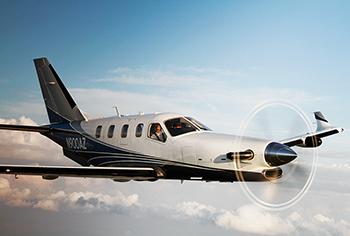
Want the very best combination of speed, range, and load-carrying capacity? A single-engine turboprop like those in the TBM series makes a great choice. Here's a brief look at how the TBM 900 stacks up against its competitors in the turboprop and owner-flown jet market. [Historical data and pricing have been preserved for the record.]
Piper PA-46-500TP Meridian
Though both turboprops seat six in pressurized comfort and derive their power from a Pratt & Whitney PT6A, that's about where the comparisons between the TBM 900 and Piper Meridian end. The Meridian is a full 70 knots slower than the TBM 900 (330 ktas vs. 260 ktas), its range is nearly 600 nm shorter (1,582 nm vs. 1,000 nm), and it weighs nearly 1,400 pounds less (7,394 lb. MTOW—max takeoff weight—vs. 5,000 lb. MTOW). But the Meridian also sells for around $2.2 million versus the TBM 900's purchase price of about $3.7 million.
Beech King Air C90GTx
There's no question that the King Air C90GTx can carry a heavy load and has more room in the cabin, but it has a hard time competing with the TBM 900 in most other metrics. The C90GTx cruises at 272 ktas versus 330 ktas for the 900, its range is limited by virtue of its second engine, and operating costs are higher as well. The price of the C90GTx at $3.8 million is nearly identical to that of the TBM 900.
Cessna Citation Mustang 510
Cessna has paused production of the Mustang, but the model both used and new remains the single most common competitor to the TBM 900. The similarities are numerous, from top speeds within 10 knots to similarly sized club-configured cabins to Garmin G1000-based avionics suites. The two major differences, jet versus turboprop and twin versus single, are disputes left to individual philosophies.
Cirrus SF50 Vision Jet
Cirrus' under-development single-engine jet seems an unlikely competitor for the more expensive, faster and longer-legged TBM 900. Then again, both models could suit pilots stepping up. While the TBM outdoes the SF50 in terms of speed (by 30 kts), range (by around 900 nm at max weight) and conventional beauty, it is not a jet and it does not have a chute. Coupled with the price delta, the SF50 could be a strong competitor for some customers.
*Preliminary figures from 2104
Pilatus PC-12
The somewhat more expensive Swiss single shares many things in common with the TBM, but as it has always been, buyers will not be confused here. The PC-12's cabin is best in class, its rough-strip capabilities are legendary, and the big door allows absurdly big loads. But the TBM is faster by a lot, more fuel efficient, and sleeker on the ramp. As always, buyers will weigh these factors versus their typical mission profile and decide. We want one of each.

Sign-up for newsletters & special offers!
Get the latest FLYING stories & special offers delivered directly to your inbox






